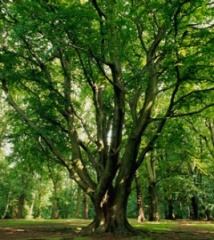Today is the First day of Autumn. We haven’t been for a walk in a while. With the rare sunshine that we are graced with today, how about we lace up our hiking boots and head out to enjoy some of the last nice days of the summer, before Autumn really takes hold. We might not get too many more chances, so…
Hi ho, Let’s Go!

In days gone by, many a beech was spared from the forester’s axe due to their heavy and tough wood. Of course the advent of the chainsaw, made this hard and strong timber attractive for use in flooring, for firewood and even for use by the brew masters in Germany, as well as the folks at Budweiser. In fact, the Old Norse word for beech is bók, which hearkens back to the day when beech trees were used for writing material, directly related to today’s word “book”. The German words today for beech and book are “buche” and “buch” accordingly, so I guess all those lovers carving their initials in beech trees weren’t far off of their forefather’s thoughts after all.

Aside from eating a few chestnuts, while Jack Frost nips at your nose, there are a few other things you can do with a chestnut tree. While blight has decimated the populations across much of North America, leaving the remaining trees only a fraction of their once glorious height, they were once a staple in barn building. Durable and resistant to the elements, chestnut wood is valuable for other outdoor projects as well, such as building fences, stakes or other small outdoor objects. The high tannin levels in the wood also made it attractive for those who tanned leather, in days before synthetic tannins were created. Beware though, as when the chestnut ages, it is more prone to splitting and warping, so take care in its use as firewood for the sparks will fly.

As far identifying the specific oak for the lay person, that is not always as easy as it sounds. There are over 400 species of oaks, with approximately 80 species in North America alone. Typically you will find their leaves with a lobed margin and the bark of the tree is heavily furrowed. I am sure you are all familiar with the oak’s fruit, which of course is the acorn. The caps on these little nuts have been known as fairy hats for probably as long as children have dreamt of those magical creatures. I have to admit that I might even have a cap or two in a drawer back home.

While you can be excused for mistaking a beech for a chestnut(especially when they are young), the weeping willow is hard not to be able to classify correctly. With its long, winnowy branches that sway in the breeze and often large height (growing up to 40-50 ft), this delicate beauty is much beloved for its ornamental purposes. You often see them near ponds or rivers, due to their ability to soak up standing water, and are prized for their adeptness at erosion control. That being said, they are adaptable to drier regions as well. One note though: due to their water seeking nature, be warned NOT to plant them near your septic system or weeping tiles, unless you are looking for trouble in the near future. Willows can grow upwards of 6-8 feet a year and are often as wide as they are tall, so be mindful of where you place it. That is unless you are planning on making lots of baskets, fish traps or sweat lodges in the near future. Of course the salicylic acid in their bark might have you in mind of using it for medicinal purposes as well, but who could get a headache on a day like today? No, we won’t be munching on them as an aspirin alternative. Let’s just enjoy its shade and the delicate music it makes in a breeze. Heck, let’s just fish.






I think An Autumn Escape | CLC Tree Services: The Blog is a well written blog article and you do a good job of writing in depth.
We appreciate hearing that! Thanks so much for stopping by today! 🙂